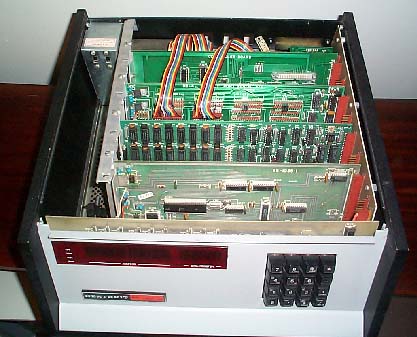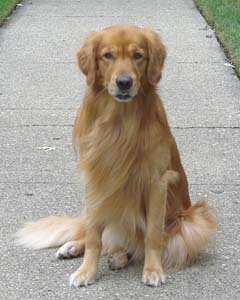

Well, here's my Web page. I guess, like most other people who put their pages on the Web, I'll have to tell you a little about myself. So here goes...
I'm "somewhat over" 50 years old and married. I'm a graduate (1978) of Purdue University Calumet (Bachelor of Science in Electrical Engineering Technology, granted "with distinction") . I was also an Instructor in Electrical Engineering Technology at PUC from 1978 to 1983. Well, the first year, I was a "Visiting Instructor," after that, I was an "Instructor."
I have a number of hobbies. The picture above actually combines two of the hobbies, amateur radio and photography. Other hobbies include bicycling and (what else?) computers. Actually, the involvement in computers is both a hobby and a business. Who says you can't mix business and pleasure?
While it's somewhat unusual for someone my age, my interest in computers dates back to high school. This is unusual because when I was in high school there was no such thing as a "personal computer." Computers were still typically large, heavy, very expensive things that sat in special air-conditioned rooms. Even "minicomputers" of that era were generally too expensive for the typical high school budget. Not to mention that the typical high school teacher of the era knew little or nothing about computers. Few high schools offered anything in the way of classes related to computers, since they had no access to a computer for students to use and probably no teachers qualified to teach anything about them anyway. As it happens, the high school where I attended had a special program where a math teacher, who at the time was pursuing additional education in computers himself, taught us Fortran programming. The city's school administration had an old IBM mainframe computer in the basement of the school administration building. One evening a week, the students in our class would go to the administration building, keypunch our programs onto cards and run our programming assignments.
Because of this early exposure to computers, when the early "personal computers" became available, I couldn't wait to get my hands on one. In those days, they weren't called "personal computers," they were typically referred to as "microcomputers." My first was a Heathkit H8, built (as many microcomputers were in those days) from a kit of parts. Note that when I say it was a "kit of parts," I mean parts. The early computer kits were nothing like putting together a "clone" PC today, which consists of little more than mounting some pre-built items in a cabinet and connecting a few pre-wired cables. When you opened the box, you unpacked bare unpopulated printed circuit boards; chassis and cabinet parts; lots of bags of resistors, capacitors, diodes, transistors, integrated circuits, wire, etc. and a "step-by-step" manual for turning everything into a computer. You had to build the cabinet from pieces, hand wire such things as the power supply and solder each component into the various circuit boards. It ran a proprietary operating system called HDOS, although later I also had CP/M (by far, the most popular OS for those early machines) installed on it. It ran at a whopping 2 MHz. For those of you who think the first personal computer was a Dell, perhaps I should say that it ran at 0.002 GHz. When I first got it, I installed 4 K (yes, K!) of memory. I remember telling my girlfriend that, when I could afford it, I was going to get another 4 K of memory to bring the system up to 8 K (8,192 bytes). I told her that 8 K was "more memory than I'd ever need." Hmmm. The system I'm using as I write this has 32,768 times that amount of memory and it just seems adequate for the task. I guess 8 K really wasn't "more memory than I'd ever need."
The H8 had one feature that I wish modern PC's would (well perhaps, could) emulate: no fans! The unit was convection cooled. Both the bottom and top cabinet panels were fully covered with ventilation slots. All the circuitry sat on cards that, while tilted back slightly to lower the overall height somewhat, were essentially vertical. As the circuitry heated up the air, it would pass out of the top of the cabinet to be replaced by room temperature air flowing in the bottom. Most importantly, all this air movement happened silently. So, after about 25 years, it's still the quietest desktop computer I ever owned. I got a bit of a laugh out of an Apple ad a couple of years ago where Apple claimed that one of their new systems was, "the first," convection cooled desktop personal computer. I suspect that Apple's claim of "first" probably centers around a very specific definition of the concept, "personal computer." My guess is that, for the purposes of that ad, Apple's definition of a "desktop personal computer" is a computer that sits on a desktop and has the word "Apple" on it.
Here are a couple of pictures of an H8 I snarfed from other Web sites...
 |
 |
When I first got it, the pictures above pretty much show what I had. You may be asking, "Where is the keyboard and screen?" The answer is that initially there wasn't one. I had to create programs in Intel 8080 machine language by hand, enter the program into sequential memory locations in the computer using the keypad on the front panel, run the program and get any result it produced by examining the appropriate memory locations or processor registers using the display on the front panel. If all this sounds crude now, rest assured it felt crude even then. Rather quickly, I expanded the memory; added floppy drives, a printer, a terminal and moved up to running an actual operating system. This allowed me to run programs by entering them at a terminal, compiling them and seeing the results on the terminal's screen. By the time the "old fellow" was retired for my first "IBM compatible" (now days, "Wintel") computer, I'd expanded it to 56 K of memory. In those days, that was a lot. The maximum memory the Intel 8080 processor, with its 16 address lines, could support was only 64 K.
The system's speed and capacity may seem puny by modern standards, but it had enough power that I wrote programs to model closed and vented box speaker systems with it. The programs I created were used to design a vented box speaker system that was constructed and tested to complete the requirements of my "senior design project" for my undergraduate degree at Purdue. Ah, those were the days! I remember writing those programs by locking myself in my bedroom (where the computer was located) and pulling "all nighters" coding the programs, occasionally emerging for some food and then returning to continue marathon coding sessions in solitary confinement. Once in a while, I'd crash on the bed for a few hours and then go back to programming. If I tried that these days, I'd probably land in the hospital.
I eventually returned to Purdue University Calumet to take some additional computer courses. Initially, my intent was just to take one class in Java, but the advisor I spoke to while attempting to enroll in the Java course tied me up in prerequisite requirements and, despite a significant background in programming spanning well over 20 years, refused to allow me to enroll in the one lousy Java class until I obtained credit for four other courses. Just to get classified as a "student," I enrolled in one course, and then "tested out" of the other three over the course of that semester. But, with the credit for those courses plus the Java course I originally wanted to take, the advisor suggested that I was only a few courses away from getting Purdue Calumet's "Post-Baccalaureate Certificate in Computer Information Systems." So, I signed up for a couple of additional courses, "tested out" of one more and finally took the Java course that started the whole adventure. In the end, I wound up getting the "Post-Baccalaureate Certificate" from Purdue Calumet in May of 2001.
Once I got back into the whole "academic thing" again, my wife suggested that I should just keep at it and get a graduate degree, something I've been considering for quite a while. In the Spring of 2002, I was accepted into the graduate program at DePaul University's School of Computer Science, Telecommunications and Information Systems, otherwise known (and thankfully, much more briefly) as DePaul CTI. Actually, as it turned out, those "extra" courses I took at Purdue wound up getting plugged in as prerequisite phase undergraduate courses for DePaul's graduate program, so they turned out being useful after all. I completed my Master of Science in Computer Science ("with distinction," no less) in the Spring of 2007. DePaul University, based in Chicago, is the largest Catholic university in the United States and the eight largest private university in the U.S. DePaul has several campuses spread around Chicago and its suburbs. The School of CTI was based at DePaul's downtown Chicago campus. I say, "was," because since my graduation the school was renamed the "College of Computing and Digital Media" and now encompasses two schools, the "School of Computing" and the "School of Cinema and Interactive Media."
I'm a member (or alumnus) of a number of organizations...
I'm a big fan of Golden Retrievers. Based on my personal experience living with them, I think they're about the best dog there is for a personal companion. I've had two, so far. My first Golden, George, died at a relatively early age (about 8 years old) from skin cancer. As much as I loved the big guy and never once regretted purchasing him, he was obtained from a pet store and was the product of a "puppy mill" in Kansas. He had a wonderful personality, kind and completely non-aggressive, but the poor guy suffered from a near continuous string of health maladies over his lifetime. Ear infections, skin infections, intestinal infections, anal gland infections, you name it. The common denominator was "infections." After he died, I did some research and learned that the cancer was probably the result of the same thing that gave him a lifetime of infections: a weak, compromised immune system caused by the dismal breeding practices of puppy mills.
Don't ever buy a puppy from a pet store. It just perpetuates the whole puppy mill problem. Even if you couldn't care less about puppy mills and the problems they cause, don't buy a pet store puppy for a selfish reason: over the course of his life, we spent thousands of dollars in vet bills getting treatment for all of George's health problems. Once you've made the decision to get a purebred puppy, find a responsible breeder and buy a puppy from someone who cares about the breed and the puppies he or she produces. Don't take your kid into the pet store. The child, who doesn't know better, will end up "falling in love" with some dismally bred pup, you'll end up giving in and buying it and quite possibly get stuck with a load of expensive trouble. Not to mention, you'll also make room at the pet store for another "puppy mill" puppy and keep the whole problem going. Also, don't fall for the "puppy guarantee" the pet shop will offer. They'll explain how if the dog has serious problems during the first few weeks or months, they'll take the dog back and give you another one. A puppy isn't a toaster. The pet shop fully understands that such a guarantee is a joke. Unlike a toaster, you and/or people in your household become emotionally attached to a puppy. After you've had the pup for a while, there's about zero chance that you'll take him back, pronounce the dog a "lemon" and ask for a replacement. After just a few days, try telling your kid, "Honey, Fluffy is a lemon. So we're taking him back to the store so they can 'put him to sleep' and getting a replacement puppy."
After George died, we'd "learned our lesson" about pet store puppies. We found a local, responsible breeder and got Trevor. We first saw him when he was only two days old. At two days, pups are deaf and blind and basically lay in a spot and sleep. He had short hair and a skinny tail. I told my wife that, except for the floppy ears, he could have been a rat. We went back to visit Trevor at the breeder at three weeks and five weeks. By three weeks, he was active and playful. At seven weeks, we brought him home. Like George, Trevor was a wonderful buddy. Kind, sweet, playful and intelligent, he was just about the perfect dog. How much difference did buying from a breeder make? Trev lived to about 11 1/2 years old and, except for annual scheduled visits to the vet for vaccinations and a check up, we didn't have a single significant health issue with him until at the end when he was dying of, "old age." We probably paid about a hundred dollars more for him than we would have paid for another pet store puppy, but if another pet store pup had the health issues of George, we would have racked up thousands in vet bills during his life. From a health standpoint, I had no idea how bad George was until I got Trevor and found out how much better it could be.
Here's a look at Trevor...
 |
 |
After Trevor died, I wasn't sure that the joy of having a dog outweighed the sadness when the dog dies. But after a few months, I relented and Nigel joined the household. Nigel is now about 1 1/2 years old. Unlike George and Trevor, Nigel is a "light" Golden. His color is more "buff" than "gold." Maybe with the next update of this page, I'll add a picture or two of Nigel?
For purebred dogs in general, the American Kennel Club offers breeder referral. It's quite likely that a pup from a real breeder will cost slightly more than a pup from a pet shop. But the number that really counts is how much the dog costs in total including vet bills over the dog's life. If you want to know more about Golden Retrievers in particular, the Golden Retriever Club of America has a Web site. They also offer breeder referrals.
Well, that about covers it. I'll be adding to this page from time-to-time. If you wish to contact me, you can always send e-mail.
Updated 10/8/11
Contents Copyright © 1996-2011 by the author except, of course, for the Heathkit computer pictures I sucked off other sites